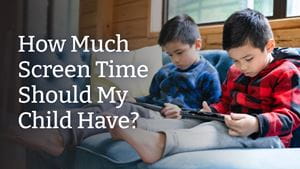
With the onset of remote learning and the growth of educational programming and apps, using screens is now part of daily life for many children.
The question for many parents is often this: how much screen time is healthy for my child?
Steven Schulz, MD, is the Rochester Regional Health Primary Care and Ambulatory Specialty Institute Pediatric Medical Director for Monroe County and Finger Lakes Medical Associates. His experience may prove helpful to parents and caregivers.
The short answer is yes.
When put into practice, those limits should look different based on the age of the child, and the type and setting of screen use.
While there is not a direct cause and effect relationship between screen time and health conditions, there are some concerns associated with overuse of screens.
Excessive screen time is linked with several health conditions, including:
The screen time recommended for children varies by age, according to the American Academy of Pediatrics.
Pediatricians recommend no screen time for infants and toddlers before they turn two. There is no real benefit, even when it comes to educational content.
The exception to this is when family members are using smartphones, tablets, or computers to chat via video (i.e., FaceTime, Google Duo). Reinforcing positive family communication is considered acceptable at this age.
At this age, pediatricians recommend no more than one hour of screens each day. The videos or games that a child is watching and/or playing on a device should be age-appropriate and educational. In addition to monitoring the content, parents or caregivers should ideally be active in watching or playing with their child to reinforce what is being shown or taught.
Once a child is school-aged, the limit can be increased to a maximum of two hours per day.
Creativity, activity, and relationships are the important areas of healthy development in which children should be encouraged to grow.
“It is important that kids are being active, that they are in relationship with other people, and that they are being creative,” Dr. Schulz said. “When you have a screen in front of you, it is generally hard to do those things.”
Beyond setting limits on time spent in front of a screen, parents and caregivers should consider not just total time, but also the quality of the content being watched.
Using devices to listen to music, read e-books, and do video calls with family are healthy activities and should not necessarily count against “screen time.”
As children reach adolescence and young adulthood, keeping a hard limit of 2 hours of screen time is still recommended, but in practice can be harder to enforce.
Dr. Schulz suggests some broader guidelines that will help youth develop self-regulating behaviors.
Screens should not be considered a given, Dr. Schulz suggests. Consider making them an earned privilege. By doing their homework, reading books, doing chores around the house, and other behaviors or tasks, kids can “earn” more screen time.
With teens, make sure their use of screens isn’t getting in the way of functioning. This is especially true if they are using a phone or tablet in their bedroom. Excessive screen time interferes with their sleep, which can be detrimental to their development and overall health.
“You want to work with them to make sure they have their independence and make their own healthy choices, but if screens are getting in the way of their physical and mental health or their relationships with other people, then it is important for parents to put additional limits on screens,” Dr. Schulz said.
Pediatricians and parents have general concerns about using screens excessively when it comes to video games, particularly violent ones.
Violent video games, TV shows, and movies have been shown to affect mood and mental health in children. It is important to be mindful of what is being watched, as well as how long it is being watched.
Social media is another significant area of focus for parents and pediatricians.
If a child is spending excessive amounts of time on these apps, they can develop issues related to bullying, mental health concerns, comparing themselves to others too much, and child predators.
Discussing and setting limits with social media can be important for their development as an adolescent and for their long-term health, as well.
“Screens are a part of life and that’s not going to change,” Dr. Schulz said. “The key is making sure that use is balanced to keep children and youth healthy.”